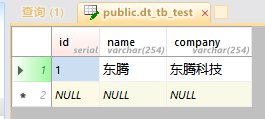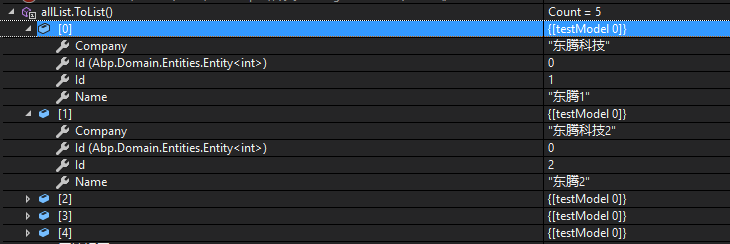Abp.NHibernate動(dòng)態(tài)庫連接PostgreSQl數(shù)據(jù)庫,供大家參考,具體內(nèi)容如下
初次接觸Abp框架,其框架中封裝的操作各類數(shù)據(jù)的方法還是很好用的,本人還在進(jìn)一步的學(xué)習(xí)當(dāng)中,并將利用abp.NHibernate類庫操作PostgreSQL數(shù)據(jù)的相關(guān)方法做一記錄,不足之處讓評論指點(diǎn)扔磚。
話不多說,直接開干:
1、vs 新建一個(gè)項(xiàng)目,(窗體或者控制臺程序或者測試程序)
2、NuGet 獲取類庫(adp.NHibernate)

還需安裝一個(gè)pgSQl 對應(yīng)的驅(qū)動(dòng)

3、新建一個(gè)繼承AbpModule的類,用于配置數(shù)據(jù)庫連接信息和實(shí)體映射的相關(guān)信息
|
1
2
3
4
5
6
7
8
9
10
11
12
13
14
15
16
17
18
19
20
21
22
23
24
25
26
27
28
29
30
31
32
33
34
35
36
|
using System.Reflection;using Abp.Configuration.Startup;using Abp.Modules;using Abp.NHibernate;using FluentNHibernate.Cfg.Db;/*** 命名空間: abpPgtest* 功 能: 配置數(shù)據(jù)庫* 類 名: NhHibernateModel* 作 者: 東騰* 時(shí) 間: 2018/1/29 17:04:27 */namespace abpPgtest{ [DependsOn(typeof(AbpNHibernateModule))] public class NhHibernateModel:AbpModule { //重寫PreInitialize方法 public override void PreInitialize() { var pgStr = "Server=localhost;Port=5432;Database=DTDB;User Id=DT;Password=DT"; var config = Configuration.Modules.AbpNHibernate().FluentConfiguration .Database(PostgreSQLConfiguration.Standard.ConnectionString(pgStr)); config.Mappings(a => a.FluentMappings.AddFromAssembly(Assembly.GetEntryAssembly())); //base.PreInitialize(); } //重寫Initialize方法 public override void Initialize() { IocManager.RegisterAssemblyByConvention(Assembly.GetCallingAssembly()); // base.Initialize(); } }} |
4、新建實(shí)體和實(shí)體映射
|
1
2
3
4
5
6
7
8
9
10
11
12
13
14
15
16
17
18
19
20
21
22
23
24
25
26
27
28
29
30
31
32
33
34
35
36
37
38
|
using System;using System.Collections.Generic;using System.Linq;using System.Text;using System.Threading.Tasks;using Abp.Domain.Entities;using Abp.NHibernate.EntityMappings;/*** 命名空間: abpPgtest.testModel* 功 能: 數(shù)據(jù)庫表實(shí)體及映射* 類 名: testModel* 作 者: 東騰* 時(shí) 間: 2018/1/29 17:21:19 */namespace abpPgtest.testModel{ public class testModelMap : EntityMap<testModel> { public testModelMap():base("dt_tb_test") { //Id(x => x.Id).GeneratedBy.Increment();//數(shù)據(jù)庫表中沒有自增的Id時(shí)需要映射一個(gè)Id Map(x => x.Company); Map(x => x.Name); //References<userModel>(a => a.Id).Not.LazyLoad().Column("外鍵ID");//數(shù)據(jù)庫中有關(guān)聯(lián)表時(shí)使用 } } public class testModel:Entity<int> { public virtual int Id { get; set; } public virtual string Name { get; set; } public virtual string Company { get; set; } }} |
5、數(shù)據(jù)庫中新建表 dt_tb_test

6、注冊并初始化abp連接
|
1
2
3
|
var bootstrapper = AbpBootstrapper.Create<NhHibernateModel>();bootstrapper.Initialize();var resp = bootstrapper.IocManager.Resolve<IRepository<testModel>>(); |
7、向數(shù)據(jù)庫中添加數(shù)據(jù)
|
1
2
3
4
5
6
7
|
//添加數(shù)據(jù) var model = new testModel { Name = "東騰", Company = "東騰科技" }; resp.Insert(model); |
打開數(shù)據(jù)庫查看結(jié)果:

8、更新數(shù)據(jù)
|
1
2
3
4
|
//更新數(shù)據(jù) var m = resp.Get(1); m.Name = "東騰1"; resp.Update(m); |
查看結(jié)果

9、查詢數(shù)據(jù)
查詢所有的數(shù)據(jù)
|
1
|
var allList = resp.GetAllList(); |

按照條件進(jìn)行查詢

10、刪除數(shù)據(jù)(可以根據(jù)多種方式進(jìn)行刪除,用id或者where條件進(jìn)行刪除)
|
1
2
3
|
//刪除數(shù)據(jù),更具where條件刪除 Expression<Func<testModel, bool>> where = a =>a.Id==3; resp.Delete(where); |
id為3的一條數(shù)據(jù)被刪除

11、總結(jié):
abp.NHibernate只是ABP中對NHIbernate的一個(gè)封裝,只要正確注冊和訪問數(shù)據(jù)庫,其余的就是ORM操作數(shù)據(jù)庫,就簡單了。其他的關(guān)系型數(shù)據(jù)都用類似的做法即可。
以上就是本文的全部內(nèi)容,希望對大家的學(xué)習(xí)有所幫助,也希望大家多多支持服務(wù)器之家。
原文鏈接:https://www.cnblogs.com/dongteng/archive/2018/01/30/8378650.html















